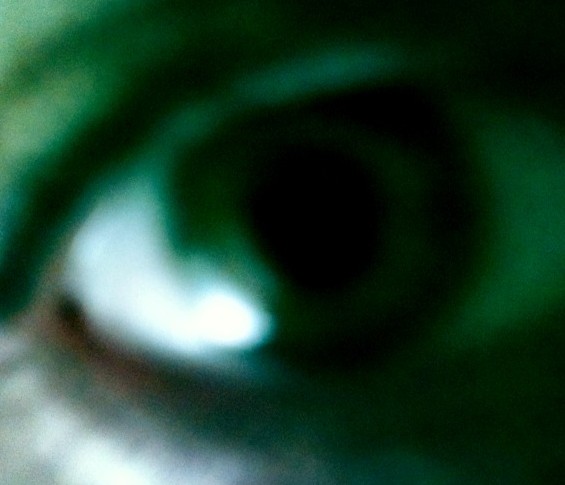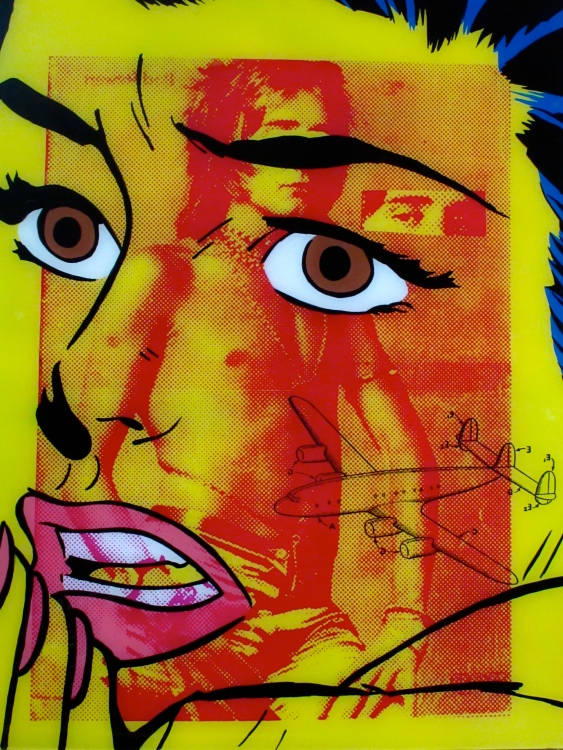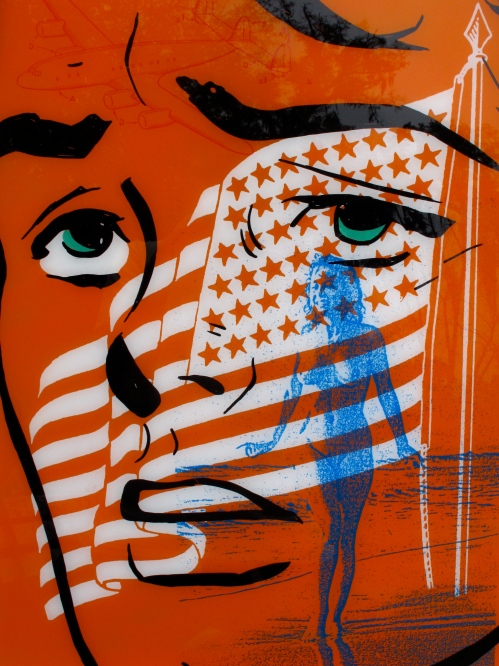Tony Rodrigues and Mark George join forces for an upcoming show
The friendship of Tony Rodrigues and Mark George was initially formed over the bond of making visual art. The two met in 1991while still in their late teens and early twenties, creating collages and assemblages that were fueled by their shared love of the DIY ethos of art-fueled entities like punk rock and Dadaism. Since then, Rodrigues and George have each enjoyed respective success by exploring their highly individual approaches. Rodrigues reappropriates found imagery of the past century and creates canvases by juxtaposing those same signifiers into a highly personal visual vocabulary that can be disturbing and playful, sometimes in the same composition. Along with spouse Wendy C. Lovejoy, Rodrigues has also created the popular line of TACT apparel that brings his eye-engaging sense of design to the world of fashion. Using greenhouse roofing material as his de facto canvas, George paints haunting, Neo-Pop art portraits in acrylics; his pieces can resemble road signs from a bygone era or surveillance snapshots that give the audience the sense of being voyeurs and witnesses to secretive, intimate exchanges. Yet despite their separate endeavors over the years, Rodrigues and George have invariably taken the time to work in cooperation and share ideas. These opportunities have been a chance for the two old friends to blow off steam, encourage one another and chart their growth from two art-enthralled teenaged punk rockers into bona fide, well-respected visual artists.
Over twenty years after their initial collaborations, the pair has been working together once again. Last November they presented the show “Teeny-Tiny! Big-Time!” at Rodrigues and Lovejoy’s TACT shop in Riverside. While that exhibit featured a small set of works, the two continued working together at a feverish pace, blending Rodrigues’ seemingly-infinite arsenal of imagery with George’s instantly-recognizable comic book faces in the form of mixed-media works on plexiglass. Since that first show, Rodrigues and George have been posting images of their ongoing work on Facebook to much positive response. Now they are readying for the opening reception for “Mistaken & Deluded,” their upcoming show at Atlanta’s ABV Gallery. The statement for the show describes it as being a kind of celebration and criticism of our “plastic society and the sleek, shiny things that inhabit it.” The opening reception for “Mistaken & Deluded” is held from 7-11 p.m. on Saturday, May 18 at ABV Gallery, 659 Auburn Ave. NE #504, in Atlanta. The show is on display through June 16. (213) 915-6448.
While they were admittedly busy in preparing for their show, Rodrigues and George agreed to answer a few questions via e-mail.
Starehouse: Tell me about this upcoming show, “Mistaken & Deluded.” How many pieces will be in the exhibit?
Tony Rodrigues: The show title is from a small collage piece that I did back in the last century. It was an image of a good-looking couple in formal wear from a cigarette ad. I paired it with the text “You are utterly mistaken and deluded” (from a religious tract, I believe). I reproduced it as a screen print years later. Mark remembered it and suggested we use it for the show title. There are 19 pieces that are 24″ x 18” and one that is 42” x 60″. I also included three 24″ x 18″ pieces that aren’t collaborations with Mark, but are done in the same format. They are all done on plexiglass, reverse drawn, painted and printed, some with a little printing on the front side as well.
Mark George: 20 pieces total.
S.: The statement for “Mistaken & Deluded” describes how the show is both “an elegy and celebration for a golden age that exists only in the selective memories of artifacts of a bankrupt, artificial culture.” What do you think are some of the factors that guide or create those very same “selective memories” in our pop consciousness or culture?
T.R.: So much of our pop culture’s history was written by marketing/advertising campaigns that it’s inextricable from the rest of our culture. If people only bought what they really needed, our economy and way of life would crumble. We are constantly bombarded by advertising and it has been a part of my landscape for my entire life. We are constantly told that the “Good Life” is right there for us to buy if we are savvy enough to recognize the products that will make us beautiful and sexy and happy. The imagery I’m using in the collaboration are from a series I have been working on titled “Opulence!/Golden Age”. It’s an exploration of our past and present ideas of the good life, status symbols, and our ideas of success and taste. It’s tongue-in-cheek, but also a bit sincere and kind of sad. The images Mark appropriates bring added drama and a feeling that things aren’t as swell as they seem. The crying young women and sneering dudes are beautiful and flawed and, obviously, bring to mind the original Pop movement. Warhol and Lichtenstein works are now, themselves, ultimate Pop status symbols. And on and on it goes.
M.G.: Coffee and LSD has mostly guided my selective memories.
S.: I know that the two of you have been intermittently collaborating for over two decades now. But in the past year you have really ramped up your activity in working together; what do you think has sustained this sort of concentrated activity? Is this the longest duration that the two of you have worked together?
T.R.: We’ve collaborated, bounced ideas off each other and shared source materials for a long time, but this time it was destined to be a long-term project. Mark saw the potential first when I started the “Opulence!/Golden Age” series and after the first few pieces were done, we just kept riding the momentum. He does multiple variations of his source imagery and my process is all about multiples and variations. This is the longest duration we’ve worked together but it has been continually gratifying and smile inducing. Mark arranged the show in Atlanta with ABV Gallery and we zoned in. The deadline was helpful and the show was something to work for.
M.G.: Well, we’re just aging like a fine wine and fancy cheese over here; just gets better with age. Yes, this is the longest duration the two of us have worked together on a specific series.
S.: After twenty years of working together, I am curious about your actual collaborative process. Has that process changed much? Could you describe how the two of you work on an individual piece? Do you have a certain idea in mind? How much of your working together is still based on what Tony described as “Exquisite Corpse”/free association?
T.R.: We did most of the work separately; we texted and sent photos back and forth of works in progress. Mark gave me his line drawings and I went from there. We would chat about colors and imagery. Overall it was very organic. Mark was familiar with the imagery I was using and what I driving at with it.
M.G.: Nothing has changed. I like to spend my free time making things. It should be a relaxing occasion that I enjoy. Not a lot of thought put into the production end. All of the ideas and direction have accumulated over various amounts of time that has been spent doing the things I do not enjoy doing, and wishing I was doing something else. I doodle in my free time and hand it over to Tony when I’m done. Exquisite Corpse.
S.: The work seems to avoid using any kind of recent visual signifiers of the past twenty to twenty five years. Why is that? What do you find so appealing about culling images from what appears to be these early-to-mid 20th century decades?
T.R.: Actually, the cars (the Cadillac with bullhorns and Trans Ams) are from contemporary ads for used cars. The cheerleader and several other images are manipulated versions of pretty current stock photos. The nudes are from early 1970s girly magazines and one is from a 1940s book on photographic lighting. The post WWII era saw an explosion of consumerism and marketing. We were promised a great deal. It was possible to buy happiness. It has defined our economy, landscape, lifestyles and our expectations. Later, Warhol changed the art world by referencing that and we are still referencing and re-referencing our past and cashing in on the “classics” and the “good old days”. They say “Fashion is cyclical”. There are plenty of clichés to go around. There is a tendency to see the past as better than it was. As a society, I think there is a vague feeling that our best days may be behind us and we are pining for a past that wasn’t exactly all it was hyped to be. There’s that, and also this stuff just looks so cool together in vibrant colors on shiny plexiglass.
M.G.: The work does not feature any kind of recent visuals from the last 25 years because I am clearly not interested in it. Nothing that has happened during the last 25 years has become interesting enough to include in my work. This is obviously a preference issue. Our work is a commentary on the condition of America in the mid-to-late 20th century, and its desire to cover insecurities, and boast proud worthlessness.
S.: A number of the pieces Mark sent me featured people with somber expressions that are then offset with images of classic American cars. Do these kinds of themes just seem to naturally develop or is that a case of something that the two of you chose to explore over several different pieces?
T.R.: Short answer: It was a natural development. We share similar sensibilities and I don’t remember ever having a conversation about the cars complimenting the beautiful comic book people. That just went without saying. I was doing my thing. Mark was doing his thing and the collaboration was just an easy thing to imagine.
M.G.: These themes have naturally developed – reflecting obsessions with materialistic possessions that will ultimately become worthless matter, in an advanced state of decomposition.
S.: When I spoke to you last year for the “Teeny-Tiny! Big-Time!” show, Mark had described how your greatest strengths stemmed from allowing your friendship to simply grow and allow a kind of spontaneity to develop. Since you have been under the deadline of this upcoming show, has it been difficult to conjure up that same spirit of impromptu creation and coincidence?
T.R.: Oh, man, that show consisted of six 24″ x 18″ pieces on plexiglass and some unique prints on paper. This was much more involved. We’ve been working on this since last fall. ABV contacted Mark before “Teeny-Tiny, Big Time!” opened. We also did a four color screen print in edition of 40 with George Cornwell at his studio at CoRK. That was a great experience. George is such a pro and that was collaboration-within-a-collaboration. Things just kept moving forward because we were both happy with the results and because of the familiarity we have with each other as pals and as artists. We might have had a couple of stress-induced tiffs, like a couple of old dudes would do. For a couple of high-strung cats with really specific standards, it was pretty easy. I don’t mean to sound like we’re on auto-pilot. This is just the pay-off from years of doing what we love and sharing our little projects.
M.G.: We’ve been preparing for this exhibit for seven months, so there has been plenty of time to casually develop ideas and produce work without compromise, that we are proud and happy to be associated with.
S.: So what’s next?
T.R.: We’re up for the next one. Of course, we both still work on our individual projects. There are a few irons in things in the works for shows regionally and nationally. We’re excited to represent Jax and N.E. Florida as a small example of the blooming arts scene here.
M.G.: Only the future will tell …
Daniel A. Brown
starehouse@gmail.com




These artists make Picasso look like a bumbling child…